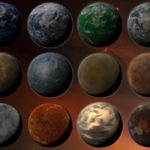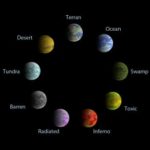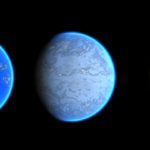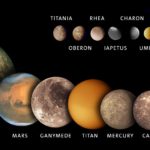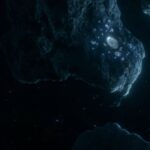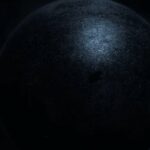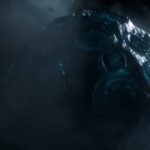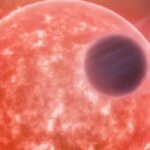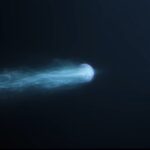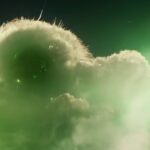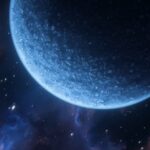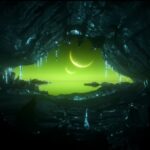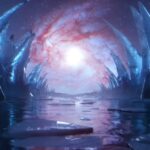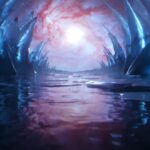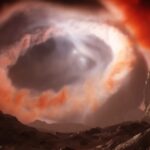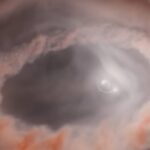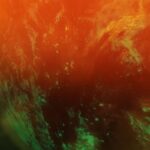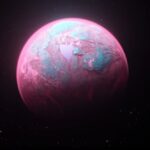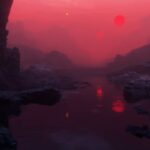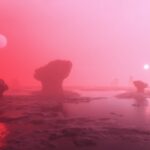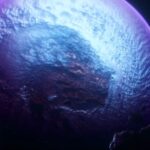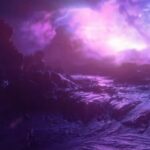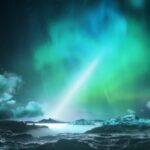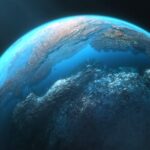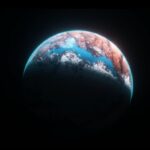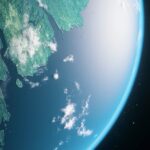These are all the different kinds of planets we have theorized and found… or manifested.
–
Table of Contents:
- Introduction
- Alphabetical Designators
- Categories
- New Planet-classification System
- Additional Notes
- Comparisons (Images Begin)
- Singles
–
Introduction:
All planets, planetoids, moons, asteroids, comets, and many other celestial bodies are clearly classified by distinct types. In the Starfleet system, these types, abbreviated to a single letter in the English alphabet, were then used as a form of short-hand to help interplanetary travelers better anticipate and prepare for the conditions of the worlds to which they were headed.
You will see these single-letter codes adjacent the columns of planet names on the Milky Way galaxy webpage; they help zero in our readers and writers as descriptors. Since that webpage’s construction, however, we have refined the planets-classification system. The top section of this webpage will show the details for the old, original, Starfleet system. The bottom section of this webpage will shoe the details for the new, refined system which the Inisfreeans use to this day.
–
Alphabetical Designators
Planets have been classified into 23 distinct types, each corresponding to 1 letter of the English alphabet. Once you identify a planet by its type, such as be calling it a ‘Class M world’, people familiar with this identification and description system will immediately understand how they must proceed if traveling to it. The following columns match the letter designator to its most simplified, plain-English descriptors, along with a an example of an actual planet, as well as how the Earth-That-Was compares to such a planet.
- A: Dwarf, very young, volcanic (ex: Gothos / Earth if smaller and during stabilization years)
- B: Dwarf, young, partially molten (ex: Mercury / Earth if smaller and during formative years)
- C: Dwarf, intermediate age, geo-inactive (ex: Pluto / Earth if smaller, cold, and barren)
- D: Tiny dwarf, intermediate age, geo-inactive (ex: Pluto / Earth if much smaller, cold, and barren)
- E: Earth-size, very young, still forming (ex: Excalbia / Earth during formative years)
- F: Earth-size, young, volcanic, bacteria (ex: Janus IV / Earth during tectonic stabilization years)
- G: Earth-size, young, terrestrial, breathable atmosphere, vegetation (ex: Delta Vega / Earth without oceans)
- H: Near-Earth-size, intermediate age, desert, drought-resistant life (ex: Dimovius / Earth if wholly Arabian or Saharan)
- I: Gas-super-giant, intermediate age, very dense (ex: Jupiter, Saturn)
- J: Gas-giant, intermediate age, dense (ex: Uranus, Neptune)
- K: Dwarf, intermediate age, rocky (ex: Mars / Earth if smaller and without oceans)
- L: Earth-size, intermediate age, rocky, forested, barely habitable (ex: Alarin III / Earth without oceans)
- M: Earth-size, intermediate age, terrestrial, oceans, breathable atmosphere (ex: Bajor, Cardassia, Gor, Kalidar, Qo’noS, Risa, Vulcan / Earth)
- N: Earth-size, intermediate age, rocky (ex: Venus / Earth with lots more global warming)
- O: Earth-size, intermediate age, terrestrial, 80% oceanic surface (ex: Azati Prime / Earth during Waterworld (movie) time and conditions)
- P: Earth-size, intermediate age, terrestrial, 80% frozen water surface (ex: Callisto, Europa, Ganymede / Earth during an ice-age)
- Q: Small to Earth-size, intermediate age, terrestrial, various surface biomes (ex: Genesis Planet / Earth if in an eccentric orbit)
- R: Small to Earth-size, intermediate age, terrestrial, deep-space rogue (ex: Ba’al, Founders’ Homeworld, Nibiru / Earth if an interstellar nomad)
- S: Gas-ultra-giant, intermediate age, very dense (ex: Tethe-Alla IV / Jupiter if larger and radiating heat)
- T: Gas-hyper-giant, intermediate age, extremely dense, can become a star (ex: Diadem / 13x Jupiter-size if nearing brown-dwarf star state)
- U: ~ migrate out of a system, resulting in major climate/surface changes (ex: [no examples yet])
- V: ~ migrate into a system, resulting in major climate/surface changes (ex: [no examples yet])
- W: Shared; migrating routinely between 2/+ systems, major changes (ex: [no examples yet])
- X: Small, intermediate age, ‘demon’ (conditions irregular/unrecognizable) (ex: Osiris / Earth if smaller and bizarre)
- Y: Near-Earth-size, old, ‘demon’ (conditions irregular/unrecognizable) (ex: Hell (planet) / Earth if bizarre)
- Z: (any size), ancient, ‘demon’ (conditions irregular/unrecognizable) (ex: (some Forerunner planets) / Earth if small or large and bizarre)
–
Categories:
Those letter-based classes are grouped into the following:
- Dwarf Terrestrial: tiny with solid surfaces
- Helian: super-Earths
- Jovian: gas-giants
- Planemo/’Rogues’: variable-size, eccentric/no-orbits
- Small Body: asteroids (~3 meters to 20 km across)
- Terrestrial: Earth-like in size and other aspects
–
New Planet-classification System:
The Starfleet system for classifying planets was visionary, groundbreaking, and quite thorough in its time, and it was used for many years with significant success. However, the Starfleet system was over-simplified in some ways, convoluted in others; at the time, it was not possible to envision to full scope of the worlds which would be found; which would have to be further understood and categorized, and it made the mistake of grouping sets of planet characteristics into commonly occurring sequences. This made the system inflexible when dealing with unique worlds which did not have all of the characteristics of one of that system’s classes. The only solution at the time, prior to the idea of rethinking the entire system, was to assign multiple letters (multiple classes) to worlds with unexpected combinations of characteristics, and even then… that after-thought work-around approach still left the problems of its classes giving users the wrong idea about which characteristics those unique planets had. For example, if a world which could not be labeled as a Class M or Class J was labeled as Class M/J, upon first reading that… it was logical for the user of this system to assume that meant the world in question had all of the characteristics of Class M and Class J worlds, when the world might only have had one or two of each, or all of one class and only one characteristic of the other class. A revision to this system, therefore, was clearly needed.
The Inisfreeans instead use this system: Instead of just one letter indicating the overall type of a planet, many of which did not end up having the same set of characteristics the Starfleet planet classes had to have to be labeled with those single-letter classifications, Inisfreeans use a group of letters and numbers in the following sequence:
- Placement/position in P (represented by ‘P’), as a fraction; the number this planet is out of all the planets orbiting its star
- Distance in AU: Astronomical Units; how far the planet is from the main/only star of its solar system
- Size in E (for Earth volume) for terrestrial worlds, or J (for standard gas-giant (‘Jovian’ as in Jove; ancient name for Jupiter) volume; 1 Jupiter) for gas worlds; J.05 = Neptune’s mass; 5% of Jupiter’s, while J1 = Jupiter’s mass, and another above J13 begins fusion, making the hyper-giant become a brown dwarf. (*The Sun would be J1000, as it is 1,000x more massive than Jupiter, and Earth would be J.00315, while Jupiter would be E317.83.)
- Age in BYO (Billions of Years Old), with the range being from BYO13.8 to BYO.0001 (which = 100,000 years old)
- Atmosphere (air pressure / atmospheric pressure / barometric pressure) in A, ranging from 0-7;
0 = none (Mercury has almost 0 atm),
1 = thinnest,
2 = thinner,
3 = thin,
4 = Earth average (1.0 atm),
5 = thick,
6 = thicker; gas-giants (8-12 atm),
7 = thickest; hyper-giants and stars (12+ atm) - Surface in S, ranging from 0-7;
0 = unknowable surface (such as the shifting gas-giants’ outermost layers),
1 = forming surface (unstable, dynamic, changing),
2 = molten surface (formed but still fluid, lava waves like an ocean’s),
3 = volcanic surface (frequent and dramatic tectonic activity; routine major earthquakes –more common and intense than those of Earth),
4 = standard Earth tectonics (usually infrequent and minor, with occasional major ones),
5 = decreasing/minimal/infrequent/negligible tectonics,
6 = geo-inactive (but was once active to some degree),
7 = has never been tectonically active - Crust thickness in CT, ranging from 0-7;
0 = none (mantle exposed because crust is still molten),
1 = thinnest (barely >0% of the world’s diameter –Earth’s crust thickness is ~.0003 to .005 (.03-.5%) of its diameter; ~3 to 43 miles thick),
2 = thinner (.001 to .005 (.1-.5%) of the diameter),
3 = thin (.005 to .01 (.5-1%) of the diameter),
4 = intermediate (1-2% of the diameter, such as is the case with Mars),
5 = thick (2-5% of the diameter, such as is the case with the Moon),
6 = thicker (5-10% of the diameter),
7 = thickest (10-100% of the diameter) - Core in C, ranging from 0-7;
0 = hollow core,
1 = plasma core,
2 = gas core,
3 = vapor core,
4 = liquid core,
5 = fluid core (such as magma; molten rock),
6 = solid core (no spin, and little to no other movement) - Gravity in G, ranging from 0-7;
0 = none,
1 = lowest; negligible; almost none (disorienting and dangerous for most Earth life; asteroids and planetesimals (*Mars’ moons; Phobos and Deimos, are 0.0005814 and 0.000306 respectively)),
2 = lower; osteoporosis risk for most vertebrate Earth life (.05-.3G; dwarf planets, normal moons, and planetoids (*Moon is .165G, Pluto is .067G)),
3 = low; fun for most Earth life (.3-1G; small planets such as Mercury and Mars),
4 = Earth’s (1G (*Venus is .91G)),
5 = high; taxing to most Earth life (~1-3G; gas-giants),
6 = higher; painful to most Earth life (~4-10G; non-Repulsine pilots experience these),
7 = highest; crushing to most Earth life (>10G; stars (Sun = 27.94G on its surface, and neutron stars are up to ~1,000,000,000,000G)) - Orbit (revolution about the star) Eccentricity in OE, ranging from 0-7;
0 = none; drifting/unknown,
1 = decaying (eccentricity is <0),
2 = circular (eccentricity = 0),
3 = elliptical (eccentricity is >0 but <1),
4 = parabolic (eccentricity = 1),
5 = hyperbolic (eccentricity is >1),
6 = so vast its path appears linear,
7 = shared/transitional - Orbit Inclination (above or below the solar plane) in OI, ranging from 0-7;
0 = none/unknown,
1 = extreme pitch (179° to 120°),
2 = intermediate pitch (120° to 60°),
3 = slight pitch (60°-1°),
4 = 0° (equatorial plane),
5 = slight roll (1° to 60°),
6 = intermediate roll (60° to 120°),
7 = extreme roll (120° to 179°) (*’low’ and ‘high’, ‘lower’ and ‘higher’, and ‘lowest and highest’ would not make sense with this planet descriptor due to the nature of the orbit; passing through both the negative and positive hemispheres around the reference plane) - Rotation in R, ranging from 0-7;
0 = none; tidally locked,
1 = slowest; 1 rotation (day-night cycle) takes longer than this world’s year; equatorial days here take longer than this world’s year,
2 = slower; equatorial days take longer than an Earth-standard month (28 days) or longer than 1/13 of this world’s year,
3 = slow; equatorial days take slightly >24 hours to slightly longer than an Earth-standard week (7 days) or 1/52 of this world’s year,
4 = equatorial days are close to the Earth-standard; 1 rotation (day-night cycle) per 24 hours,
5 = fast; equatorial days take less than the Earth-standard (<24 hours) but more than 1 hour,
6 = faster; equatorial days take less than the Earth-standard hour but more than 1 minute,
7 = fastest; equatorial days take less than the Earth-standard minute (gravity on the inner surface of a hollow world rotating at this speed would be crushing, while attempts to land on the outer surface could result in being launched back into Space) - Axial Tilt in AT, ranging from 0-7;
0 = none,
1 = 0-30° (Jupiter is 3.3°, Moon is 6.68°, Earth is 23.4°, Mars is 25.19°, Saturn is 26.73°, Neptune is 28.32°),
2 = 30-60°,
3 = 60-90°,
4 = 90-120° (Uranus is 97°, making it rotate sideways relative all other planets in the Sun solar system),
5 = 120-150° (Pluto is 122.53°),
6 = 150-180°,
7 = 180° (Venus is 177.36°, making it rotate backward relative all other planets in the Sun solar system) - Day-night cycle in D, ranging from 0-7;
0 = none; tidally locked,
1 = always obscured (100% of the time; days per year (*Venus is a prime example.)),
2 = often obscured (99%-80% of the time),
3 = sometimes/routinely obscured (80%-60% of the time),
4 = Earth-standard; 2 equinoxes and 2 solstices with occasional/seasonal inclement weather obscuring exact time of day (60%-40% of the time, depending on region and season (*Colombia, Scotland, Seattle, Venezuela, and southeast Asia during monsoon season are usually at 60%, while the Sahara and most other places are closer to 40%, and the Dry Valleys being a fluke at 0%)),
5 = infrequently but not rarely –and not necessarily seasonally (40%-20% of the time),
6 = rarely obscured (20%-1% of the time (*Mars is an example.)),
7 = never obscured (0% of the time (*Mercury and Pluto are examples.)) - Elements of the Periodic Table (in the crust) in EPT, ranging from 0-11;
0 = no known elements (not even known to the ICVs yet; this world is not yet scanned/analyzed),
1 = predominantly unknown/non-Earth elements (such as SRC and others known to the ICVs),
2 = predominantly Alkali metals,
3 = predominantly Alkaline earth metals,
4 = predominantly Lanthanoids,
5 = predominantly Actinoids,
6 = predominantly Transition metals,
7 = predominantly Post-transition metals,
8 = predominantly metalloids,
9 = predominantly ‘other nonmetals’ (H, C, N, O, P, S, and/or Se),
10 = predominantly halogens,
11 = predominantly noble gases
(more info’ about these elements, such as at which temperature each one enters a new state (e.g. solid, liquid, gas), navigate to this website) - Surface Temperature in ST, ranging from 0-7;
0 = coldest (inter-stellar medium temperature; the temperature of Deep Space; ~-455°F, to ice dwarf temperature; -350°F (*Pluto = -396.67°F, )),
1 = colder; -350°F to -250°F,
2 = cold; -250°F to -150°F (*Mars = -128.47°F (night) to -24.07 (day)),
3 = average; cool to warm (*Earth = -128.6°F (coldest night near South Pole) to 134°F (hottest day in Death Valley)),
4 = hot; 150-500°F,
5 = hotter; 500-1,200°F –such as ‘green-house worlds’ (*Mercury = -279.67°F (night) to 845.33°F (day), and Venus = 866.93°F, at which point Zinc, Tin, and Lead are melted)),
6 = hottest terrestrial; fluid surface; lava; highly volcanic (~1,200+°F),
7 = hottest gas-giant to ultra-giant temperatures (~-230°F in the clouds, and ~45,000-65,000°F at the core, meaning even Carbon would melt before reaching the core (*Uranus = -371.2°F (upper cloud level) to ~8,540°F (at the core), Neptune = -330.07°F (upper cloud level) to ~9,260°F (at the core), Saturn = -218.47°F (upper cloud level) to ~21,000°F (at the core), Jupiter = -234°F (upper cloud level) to ~64,000°F (at the core), and ~100,000,000°C; 180,000,032°F is the threshold of fusion which would turn a hyper-giant into a dwarf star)) - Surface Albedo (radiation) in SA, ranging from 0-7;
0 = none; radiation-blasted surface like nuclear fallout,
1 = lowest; radiation sickness risk (~.01-.1 (*Ceres = .090)),
2 = lower; serious skin cancer risk (~.1-.2 (*Mercury = .106, Moon = .12)),
3 = low; severe sunburn risk (~.2-.3; common (*Mars = .25)),
4 = Earth-standard (~.3-.4, because a magnetosphere helps deflect much of the solar radiation),
5 = high (~.4-.5 (*Neptune = .41, Saturn = .47)),
6 = higher (~.5-.6 (*Uranus = .51, Jupiter = .52)),
7 = highest (~.6-1.0 (*Venus = .65, Europa = .67, Eris = .96, Enceladus = .99, and Pluto ranges from .49 to .66 depending on where it is along its orbit)) - Surface coverage by Liquid (not necessarily water) in SL, ranging from 0-7;
0 = none (not even ponds),
1 = 1-15% (streams and ponds),
2 = 15-30% (creeks and lakes),
3 = 30-45% (small rivers and bays),
4 = 45-60% (medium-sized rivers and gulfs),
5 = 60-75% (large rivers and seas (*Earth is 71%)),
6 = 75-90% (oceans),
7 = 90-100% (ocean world) - Climates in K, ranging from 0-12;
0 = new/unknown,
1 = hottest/driest (Arid),
2 = hotter/drier (Semi-arid),
3 = hot/dry (Mediterranean),
4 = hot and sometimes dry, sometimes wet (Tropical Wet and Dry),
5 = hot and wet (Tropical Wet),
6 = warmer (Humid Subtropical),
7 = warm (Humid Continental),
8 = cool (Marine West Coast),
9 = cold (Subarctic/Boreal),
10 = colder (Tundra),
11 = highest so usually also colder to coldest (Highland),
12 = coldest so usually also dry (Icecap) - Biomes in B, ranging from 0-29;
0 = new/unknown,
1 = tropical rainforest (and jungle, though jungles are slightly drier),
2 = tropical and subtropical moist broadleaf forests,
3 = tropical and subtropical dry broadleaf forests,
4 = tropical and subtropical coniferous forests,
5 = tropical and subtropical grassland/savanna and shrubland,
6 = subtropical rainforest,
7 = subtropical dry forest,
8 = temperate broadleaf and mixed forests,
9 = temperate coniferous forest,
10 = temperate steppe,
11 = dry steppe,
12 = semiarid desert,
13 = arid desert; barren (sand and/or ice),
14 = xeric shrubland,
15 = temperate grassland/savanna,
16 = flooded grassland/savanna; marsh/wetland/swamp,
17 = tree savanna,
18 = Mediterranean forest, woodland, and scrub/sclerophyll forest,
19 = monsoon forest,
20 = mangrove (tidal swamp),
21 = alpine/montane grassland and shrubland,
22 = alpine/montane forest,
23 = alpine/montane tundra,
24 = taiga/boreal forest,
25 = tundra,
26 = ice sheet and polar desert (glacial),
27 = aquatic (freshwater; 13 subtypes),
28 = marine (saltwater/sea/ocean; 3 subtypes: coastal, continental shelf, deep sea),
29 = endolithic (deep cave/crust) - Life in L, ranging from 0-7;
0 = none,
1 = predominantly primitive; microscopic/single-cellular,
2 = predominantly primitive; microscopic/multi-cellular,
3 = predominantly plants,
4 = invertebrates present,
5 = vertebrates present,
6 = technologically capable (though not yet Space-faring, etc.) life of some sort or various sorts,
7 = technologically advanced (Space-faring, etc.) life of some sort or various sorts - Intelligence Quotient (including Emotional Intelligence Quotient; EQ a.k.a. EI) in Q, ranging from 0-7;
0 = none (extinct –or N/A due to no comparable brains),
1 = IQ of 40-70 (mentally retarded),
2 = IQ of 70-85 (below average human intelligence),
3 = IQ of 85-115 (average human intelligence),
4 = IQ of 115-130 (above average human intelligence),
5 = IQ of 130-145 (high human intelligence),
6 = IQ of 145-175 (very high (to highest known) human intelligence),
7 = IQ of 175+; unmeasured/immeasurable (relative to humans) - Military (service) in M, ranging from 0-7;
0 = none,
1 = stand-by reserves (some are activated for emergencies),
2 = small standing (<1% of the population is on active duty),
3 = average standing (~1% of the population is on active duty),
4 = medium-size standing (2-25%),
5 = large standing (25-90% of the population is on active duty),
6 = total part-time (100% serve for a portion of their lives),
7 = total lifelong (100% serve for life) - Space Navy (range) in N, ranging from 0-7;
0 = none (may have a Space program in its fledgling stage, but no way to defend it beyond the atmosphere),
1 = surface to orbit (relatively primitive interceptor aerospacecraft such as the B-3 Aurora, or long-range lasers mounted on observatories or aircraft nose-cones),
2 = inter-planetary (usually involving sub-light (below light-speed) travel, such as via hyper-drives),
3 = out to the homeworld’s solar system’s Kuiper Belt equivalent (usually involving relative-FTL travel, such as via warp-drives),
4 = out to the homeworld’s solar system’s Oort Cloud equivalent (usually involving relative-FTL travel, such as warp-surfing),
5 = beyond the inter-stellar medium; inter-stellar (usually involving relative-FTL travel, such as Mass Relays (which instantly connect to each other)),
6 = beyond the inter-galactic medium; inter-galactic (usually involving relative-FTL travel, such as Star-gates),
7 = beyond the inter-universal medium; inter-dimensional (usually involving phase-shifting, such as to access the Webway) - Formidability (relative Inisfree) in F, ranging from 0-7;
0 = negligible (pre-nuclear technology),
1 = potential or active annoyance (such as via nuclear to thermonuclear weaponry),
2 = potential average threat (such as via the ongoing development of/toward photon weaponry; more powerful than thermonuclear bombs but less powerful than black-hole/nova devices),
3 = active average threat (such as via photon weaponry; more powerful than thermonuclear bombs but less powerful than black-hole/nova devices),
4 = potential major threat (such as via the ongoing development of/toward stellar weaponry, such as black-hole/nova devices),
5 = active major threat (such as via stellar weaponry, such as black-hole/nova devices),
6 = potential severe threat (such as via the ongoing development of/toward Temporis or omni-interfacing technology),
7 = active severe threat (such as via Temporis or omni-interfacing technology) (*Inisfreeans, Inisfree, and all Inisfreean constructs are invincible, however the Outlander things we enjoy are always at some degree of risk, so the threat to us is indirect; based on whether or not it hinders our desired interaction with compatible Outlanders.) - Libido of indigenous humanoids in H (for horniness), ranging from 0-7;
0 = none (asexual; not just asexual reproduction or no reproduction; no sex or sex-like activity),
1 = lowest; infrequent even across a decade,
2 = lower; annually,
3 = low; monthly,
4 = average (Earth-human standard; weekly if possible),
5 = high (Inisfree-standard; daily to hourly),
6 = higher than Inisfree-standard (more than several times per hour),
7 = highest; extreme (nymphomaniacal; ~constant to constant; to the point of being annoying to Inisfreeans) - Compatibility (with Inisfreeans / the Inisfreean Way) in I, ranging from 0-7;
0 = not at all (and potentially diametrically opposed; polar opposites likely to become hostile indefinitely),
1 = lowest (able to interact civilly under supervision and from a distance, such as through radio transmissions),
2 = lower (able to interact civilly via teleconferences),
3 = low; slightly below average (able to interact civilly via 5-senses transmissions; like TV with smells, tastes, and feelings added),
4 = average (able to interact as platonic friends via 5-senses transmissions; like TV with smells, tastes, and feelings added),
5 = high; above average (able to interact as platonic friends in-person in compatible Outlands realms),
6 = higher; mostly (able to interact as fuck-buddies in compatible Outlands realms),
7 = highest; fully (possibly already interacting with Inisfreeans on perfectly mutually agreeable terms even in the Inisfreean realm, such as Inisfree’s ships, Inisfree, or Star-system Auzdein)
Letters used (in order): P, AU, E/J, BYO, A, S, CT, C, G, OE, OI, R, AT, D, EPT, ST, SA, SL, K, B, L, Q, M, N, F, H, I
Letters remaining: V, W, X, Y, Z
Component Examples:
- P3/9 = the planet is the 3rd out from its star, its solar system having 9 planets
- AU1 = the planet is 1 AU from its star; the same distance Earth is from the Sun
- E1 = the planet is the same volume (and likely the same diameter) as the Earth
- BYO4.5 = 4,500,000,000 years old; the same age as most of the worlds in the Sun solar system
- A4 = comparable to Earth’s atmospheric pressure
In English, slashes indicate “or” or “of” (such as in fractions), dashes indicate range (such as “1-4” = “1 through 4”), so in order to separate the sections of each planet classification’s alphanumeric sequence, we first made sure all components were letters, and all subdivisions of components were numbers, then used the ‘vertical bar’ (a.k.a. ‘pipe symbol’) to further distinguish the different alphanumeric components. Commas are used to list non-sequential numbers following a letter, such as if a world has several biomes which cannot be expressed with a dash which would indicate “through, inclusive”.
Inisfreean Planet-classification Examples:
- Earth: P3/9|AU1|E1|BYO4.54|A4|S4|CT1|C5|G4|OE_|OI_|R_|AT_|D_|EPT_|ST_|SA_|SL5|K1-9|B1-29|L_|Q_|M_|N_|F_|H4|I_ (the underscores = numerical values on those scales yet to be entered here)
- Jupiter: P5/9|AU5.2|J1|BYO4.5|A_|S0|CT_|C_|G_|OE_|OI_|R_|AT_|D_|EPT_|ST_|SA_|SL0|K_|B_|L_|Q_|M_|N_|F_|H_|I_
So if a solar system has a name, you can tack it on as a forename (first name), such as:
- SunAU1E1BYO4.54A4S4C5G4OEOIRATDEPT…
Due to how long these classifications are when written, it is more accurate to call them a short-hand planet-description system, and the older/previous (Starfleet) planet-classes system may still be used as further short-hand, such as when one does not need to know all the basic characteristics of a world. For example, if one only needs to know if it is terrestrial or gas-giant, young or old, hot or cold, garden world or barren, etc., then the ultra-simple “Class M” or “Class J”, etc., could suffice.
–
Additional Notes:
The elements and major deposits on worlds can indicate what their function as part of Yggdrasil was –and who built what upon them, such as terraformers that petrified, and ring-systems (all of which, it turns out, are man-made… or, more accurately, angel-made). Larger than the Titans were the first gods; they were sometimes in spherical forms, long before languages and even terrestrial physical bodies had developed. ‘Space Whales‘ is one term for the cosmic bodies of that first and longest of the eras. Understanding how bodies and beings back then functioned (as multi-dimensional, not just physical in this plane of existence we are used to), and what got drawn into their remains as they petrified, helps us reverse-engineer not just technological devices, but entire worlds and solar systems.
…
Perhaps cosmic bodies are NOT gravitationally bound; they may be electromagnetically-locked like how superconductors can become… because it is so cold out there. Space is the perfect environment to maintain superconductor interactions/applications. This would be true on any scale, microscopic and nanometric all the way up to cosmic/stellar and even intergalactic –possibly even interdimensional; maybe even the different universes are somehow fixed/locked in place, relative one another. Maybe even things in time, and different timestreams relative one another, can become so.
…
August 2023: Humans assumed that gravity is what holds stars and planets in orbits, but what if it was Space that is orbiting them, and all of them are fixed, and that is just how the ideas of Sphere Beings work and appear to us?
…
Those helioformed from gas-giants into proto-stars don’t mind, and just “go with it” the same way a human would adjust to temperature outside changing seasonally. Besides, with their multi-billion-year lifespans, the humans could change tons of things about them, and it would only relatively be for “the blink of an eye” on their (the planets’) scale/time.
…
2024 February: Many, if not most, if not all, planets are Dyson Spheres; they are a hollow shell around a central star (portal; Muspelheim gate).
–
Comparisons:
–
Singles:
–


